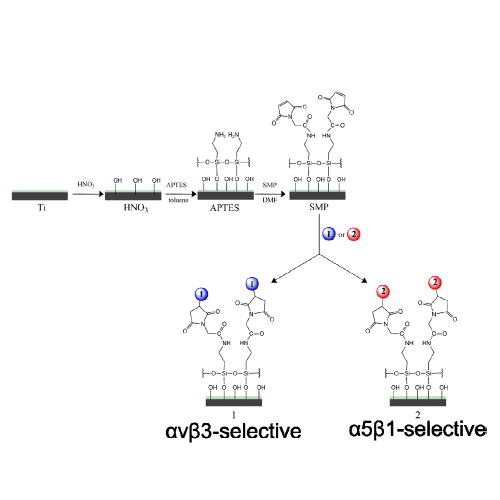Mimicking bone extracellular matrix: Integrin-binding peptidomimetics enhance osteoblast-like cells adhesion, proliferation, and differentiation on titanium
01-Apr-2015
Colloids and Surfaces B: Biointerfaces, 2015, doi:10.1016/j.colsurfb.2014.12.057, Volume 128, Pages 191–200 published on 01.04.2015
Colloids and Surfaces B: Biointerfaces, online article
Colloids and Surfaces B: Biointerfaces, online article
lInteraction between the surface of implants and biological tissues is a key aspect of biomaterials research. Apart from fulfilling the non-toxicity and structural requirements, synthetic materials are asked to direct cell response, offering engineered cues that provide specific instructions to cells. This work explores the functionalization of titanium with integrin-binding peptidomimetics as a novel and powerful strategy to improve the adhesion, proliferation and differentiation of osteoblast-like cells to implant materials. Such biomimetic strategy aims at targeting integrins αvβ3 and α5β1, which are highly expressed on osteoblasts and are essential for many fundamental functions in bone tissue development. The successful grafting of the bioactive molecules on titanium is proven by contact angle measurements, X-ray photoelectron spectroscopy and fluorescent labeling. Early attachment and spreading of cells are statistically enhanced by both peptidomimetics compared to unmodified titanium, reaching values of cell adhesion comparable to those obtained with full-length extracellular matrix proteins. Moreover, an increase in alkaline phosphatase activity, and statistically higher cell proliferation and mineralization are observed on surfaces coated with the peptidomimetics. This study shows an unprecedented biological activity for low-molecular-weight ligands on titanium, and gives striking evidence of the potential of these molecules to foster bone regeneration on implant materials.











